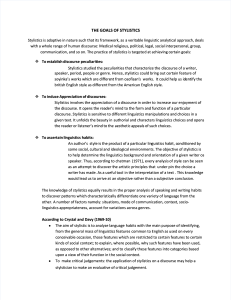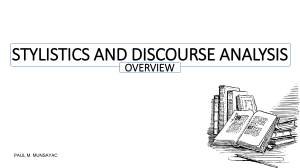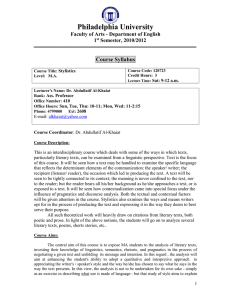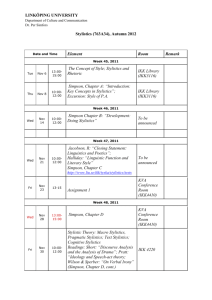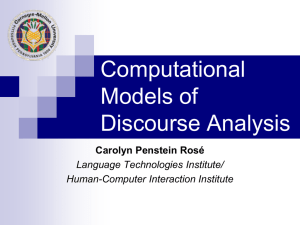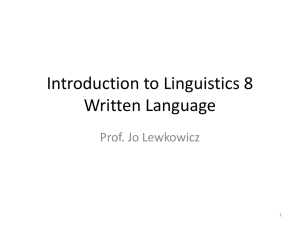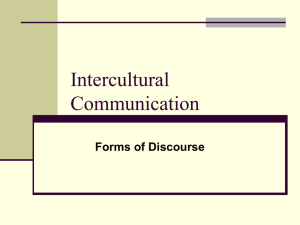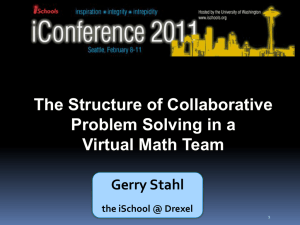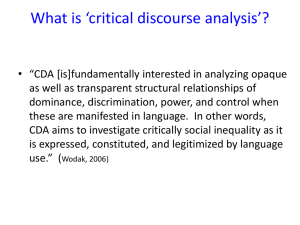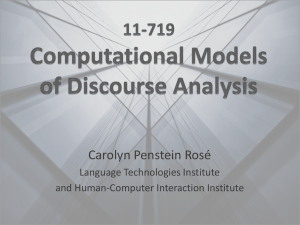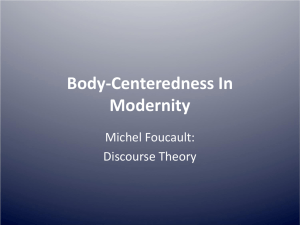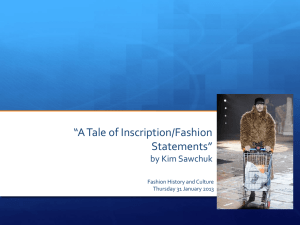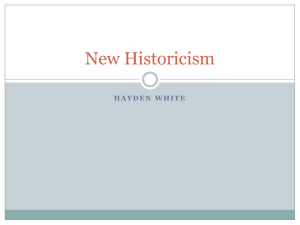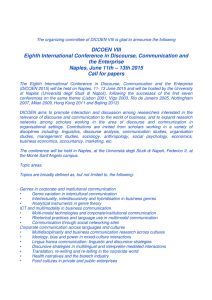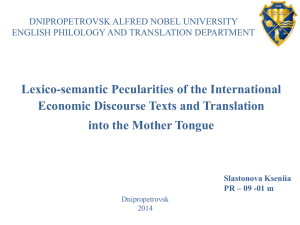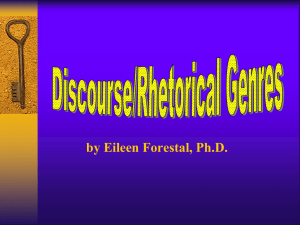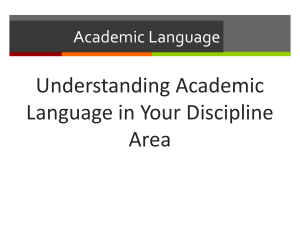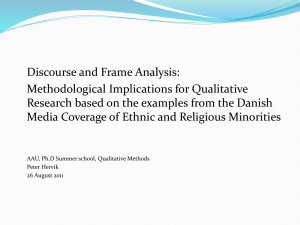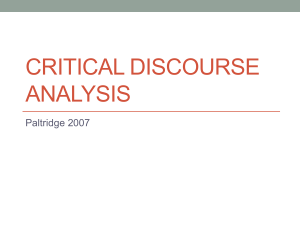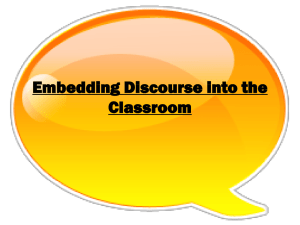Discourse stylistics - LLAS Centre for Languages, Linguistics and
advertisement
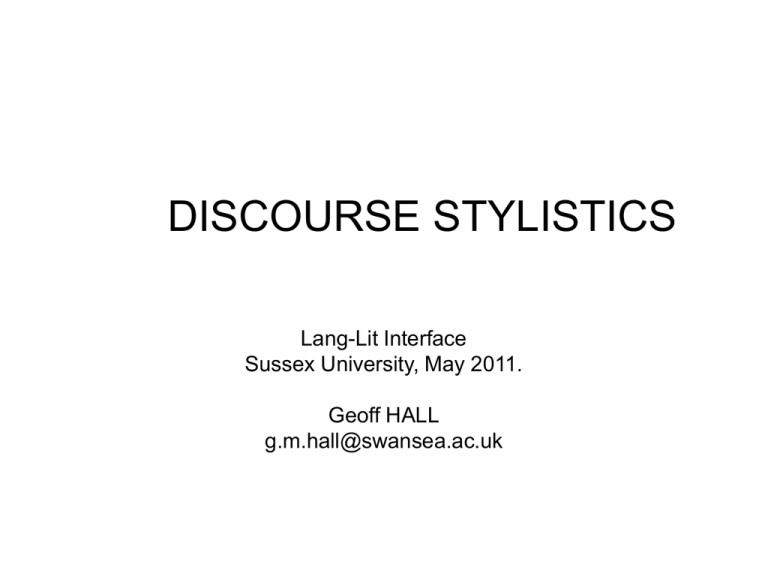
DISCOURSE STYLISTICS Lang-Lit Interface Sussex University, May 2011. Geoff HALL g.m.hall@swansea.ac.uk Outline • • • • 1. What is DS? 2. What relevance to the L-L ‘Interface’? 3. How does DS proceed in practice? 4. What might convincing DS look like? (Tennyson e.g. ‘Charge of Light Brigade’a canonical historical text) Carter & Simpson 1989 • Fowler 1981, 21: • “The absence of any necessary and sufficient linguistic criterion for the ‘literary’ text is well known” (quoted p. 13) • ‘Too narrow a focus on linguistic forms does not release what is essentially of interest in the study of literary texts’ • (Carter and Simpson 1989: 4) • ‘The 1990s could well become the decade in which socio-historical and socio-cultural stylistic studies are a main preoccupation’ (Carter & Simpson) Weber 1996: 3 • ‘Meaning and stylistic effect are not fixed and stable, and cannot be dug out of the text as in an archaeological approach, but they have to be seen as a potential which is realized in a (real) reader’s mind, the product of a dialogic interaction between author, the author’s context of production, the text, the reader and the reader’s context of reception – where context includes all sorts of sociohistorical, cultural and intertextual factors.’ Simpson & Hall 2002 • ‘Discourse stylistics views literary texts as instances of naturally occurring language use in a social context, where discourse analysis should reveal as much about the contexts as about the text.’ (136) • ‘Discourse stylistics at its best will necessarily be a thoroughgoing interdisciplinary, even transdisciplinary, endeavour.’ (136) ‘Discourse’ • ‘Discourse’ is understood as ‘language in use’ • ‘stylistics’ is the principled and systematic study of language in use• interpretation and the study of meaning through close interrogation of the formal features of texts • recognising that formal features do not have self-evident meanings but do have contexts of use and histories of reception Discourse analysis • Discourse analysis considers the formal features of language in use at every level in pursuit of larger social and cultural questions: • “WHY THIS HERE?” • Literature is an instance of language in use – ‘social interaction’ Tennyson example ‘Charge of the Light Brigade’ • formal features, artistry (repetition, parallelism etc) and their functions • use of sources to create a poem (after Ricks and McGann) • cultural intertextualities and appropriations – discourses of militarism, masculinity Formal features • parallelism, alliteration, assonance, metre, rhyme etc. create a memorable poem • use of imperative forms, inversions, imperfect rhymes, hurried and imperfect progression • students need to spend time investigating formal features that they do not otherwise notice or refer to except partially and impressionistically Use of sources: story into classic literature • use of newspaper reports shows consistent mythologising and creation of literariness incl ‘literary’ diction (‘league’ replaces ‘miles’; Death/ Hell capitalised) • 607 reduced to 600 for metre; Light Cavalry Brigade becomes Light brigade • Nolan/ the captain becomes ‘someone’ had blundered (officer’s mistake no longer primary focus) • ‘all the world wondered’ – the French officers wondered (see McGann) Kipling 1915 “If any question why we died Tell them, because our fathers lied.” (Kipling 1915) • film versions 1912 (silent b/w), 1936 (Errol Flynn), 1968 colour. • 1970s ‘English school textbooks. • Star Trek episode ... • References • • • Carter, R. & Simpson, P. (eds.) 1989 Language, Discourse and Literature London: Unwin Hyman. Fowler, R 1981 Literature as Social Discourse London: Batsford. Ricks, C. (ed) 1987 Poems of Tennyson in three volumes. Vol. 2. Editor’s Notes to Poem 315. (Charge) Harlow, Longman McGann, J. J. The Beauty of Inflections. pp. 190-203. Oxford: Clarendon Press. Simpson, P. and Hall, G. 2002 Discourse analysis and stylistics. Annual Review of Applied Linguistics 22: 136-49. New York: Cambridge University Press, pp. 136-49 Weber, J.J. 1996 Towards contextualized stylistics: an overview. In J.J. Weber (ed.) The Stylistics Reader. London: Arnold. • • •
